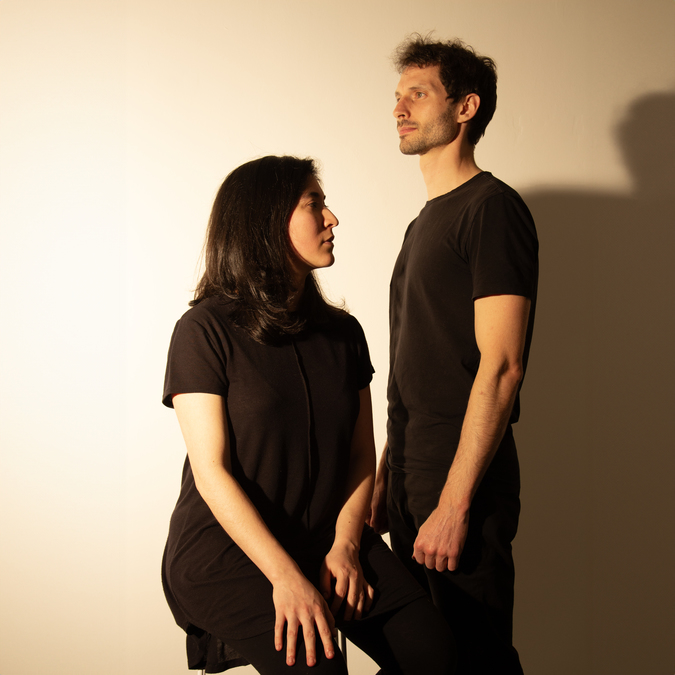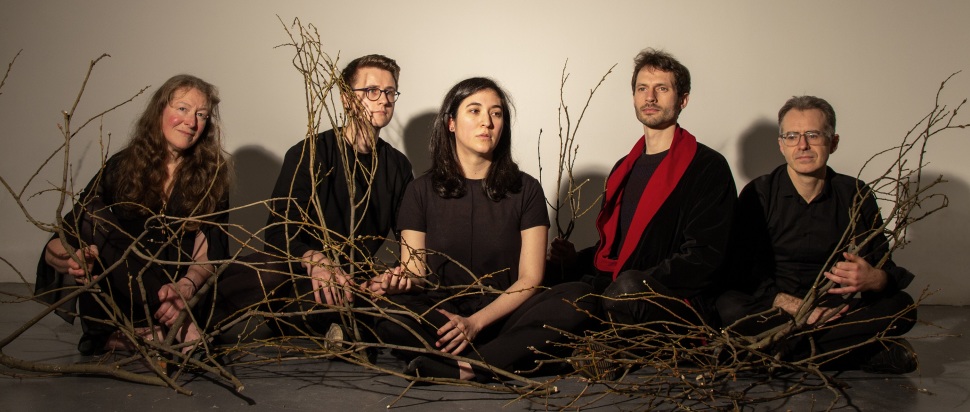Spotlight On... Stephanie Lamprea and Tom W. Green
Glasgow-based soprano Stephanie Lamprea and composer Tom W. Green team up on an adventurous new album, Don’t Add To Heartache
The sounds of morning birdsong, rustling leaves and running water coexist with groaning synths, artificial voices and looped samples in the world of Don’t Add To Heartache, where British composer Tom W. Green terraforms a rich soundscape for Colombian-American soprano Stephanie Lamprea to explore and test the boundaries of operatic vocals. Commissioned by the folks behind Hidden Door Festival in Edinburgh, this fascinating sonic experiment attempts to answer a very pertinent question – by making contact with nature, are we connecting, or are we destroying?
With the assistance of flautist Richard Craig, saxophonist Richard Schofield and violist Katherine Wren, Green’s compositions boast primal acoustic sounds that are interwoven with Lamprea’s symphony of sporadic gasps, intricate vocal runs and poetic monologues to create an album that is equal parts urgent and indulgent. For this week's Spotlight On... we catch up with Lamprea and Green in the hopes they can help us traverse the dense forest of this ambitious project.

Image: Stephanie Lamprea and Tom W. Green by Oana Stanciu
How did your first ideas for the album begin to form? What did you enjoy about working together?
Stephanie Lamprea: The first musical ideas we created came from working with photographer Oana Stanciu, who created a video installation for our live performance of the album at the 2023 Hidden Door Festival. A few months before the festival, Tom, Oana, and I met to discuss album concepts and texts, and we then took photographs of us interacting with materials (branches, ceramic masks, and papier mâché) to imitate nature. After this session, I then improvised musical material with voice and electronics, based on our experience with the materials. The first track of the album, We come into the world..., is one of those improvisations, in which I used layers and delays of my voice to sonify the waving of branches.
We also created a lot of material with dance artist Penny Chivas, who performed with us at Hidden Door. Tom, Penny and I had several workshop sessions in which Tom and I improvised musical material based on movements created by Penny. A lot of what we created in these sessions ended up in composed elements of the album, and at Hidden Door we performed in a way that all musicians could see Penny and improvise elements based on her work. The second track of the album, Imprints of our Botanizing, is a free improvisation that was directly inspired by Penny's movements.
Tom is a brilliant composer and innovator of the digital voice in operatic context; I learned so much about the capabilities and impact of digital voice working with him. We also spent a lot of time talking about the texts we set, as well as our views of nature and our shared values and beliefs. There was a lot of trust we had to place in handing musical material to each other and taking risks together as artists. I believe the process made us stronger artists and closer friends.
Tom W. Green: My idea for the live show was that every sound I made would originate in Stephanie's voice. As she improvised and sang our compositions, I would live-sample her microphone and then play her voice back on my keyboard for her to duet with, sometimes as a clear doppelganger, sometimes as an enormous demented choir transformed far from the original sound. Stephanie is a very visceral performer, and our improvising intuitions combine in ways that surprise me. I wanted to try and capture some of that on a record, and so the recording had to come from a live source.
How did you come to work with Richard Craig, Richard Scholfield and Katherine Wren? How did they influence the end product?
SL: I invited Richard Craig to the project, having worked with him on a few projects in 2023, and we now work together as an experimental chamber music duo. Tom invited Richard Scholfield and Katherine Wren to the project, knowing both of them as established artists in the Scottish classical music scene, as well as experienced improvisors.
[All three of them] were very influential to the success and aural diversity of the album. They improvised exciting material that brought the text I was singing (or speaking) to life, and they picked up so quickly on different sounds and motifs in the music and supported my vocals in ways I didn't expect. It was thrilling!
TWG: We wanted some instrumental colours to weave into this very vocal-focused world, and so we invited some of the most inventive improvisers we know. Once they got the feel of the project, they were also imitating and ghosting the voice too, but from their respective instruments, and so their contribution just expanded the palette of what we were doing without changing the direction at all.
This album has a soundscape influenced heavily by the sounds of nature, but it also has its robotic, artificial and sterile elements – what sort of sonic environment were you trying to create for your listeners?
SL: At times, we wanted to use electronics on the voice and on natural elements in the music (such as field recordings, or looped samples from live manipulated natural materials) to demonstrate scenarios in which humans are entering and interacting with nature, whether that be through pollution, sharing space, or anthropocentric bias in nature-related literature. We used electronics to create an intentionally artificial layer that at times felt like humans trespassing into non-human environments.
At other times, we wanted the electronics to equalise the relationship between humans and nature in the performance. By overlaying electronics and acoustic sounds, sometimes the voice and instruments sounded like nature, or sometimes nature sounded like a voice. Part of what we were doing was de-familiarising nature for the listener. In this way, both humans and non-humans (inanimate and animate natural beings either prerecorded or sampled live) had central roles in the musical performance, and humans and nature could both speak in the album on quasi-equal terms.
TWG: We have always constructed nature; materially, biologically, but also in narrative, literature, painting etc. I like to illustrate that in sound, and for this project it was all juxtaposition: lush field recordings of forests and birds, overlaid with artificial voices reading bucolic 'nature' poetry.
Stephanie, your vocal expression on the album is fascinating – a blend of poetic monologuing, sporadic breathwork and gorgeous operatic runs – what was the thought behind this eclectic mixture?
SL: I'm very much a believer in Lisa Peck’s idea of the ‘multiple-voice’. This is a feminist concept that a voice can express multiple and divergent sounds in ways that exceed cultural prescriptions placed on voices in traditional performance. I’ve also been really influenced by [philosopher and cultural theorist] Mladen Dolar’s concept of the 'voice beyond the signifier', meaning the inherent expressivity of the voice without the use of words.
As a trained opera singer, I like to present my voice in a variety of ways that break away from traditions of opera, but also recontextualise and modernise the use of the operatic sound. By using breath, spoken word, and singing vocals in Don’t Add To Heartache, I use my voice to show different characters or perspectives in nature, and I particularly use non-text sounds to show some pretty vulnerable and raw emotions.
Where did the album title – Don’t Add To Heartache – come from?
SL: The title comes from Juliana Spahr's poem, Gentle Now, Don't Add To Heartache. The poem is in five parts, which you can hear in tracks one, three, five, seven and nine of the album.
TWG: The poem is a sprawling epic that explores the idea of ecological grief; listing extinct species and making vulgar juxtapositions with consumer culture. It never uses the word 'nature', or frames ecological loss as anything external to us – the loss is always also ours.
SL: It's a powerful work, and we felt it tied together a lot of what we wanted to say in our album, and so we used the poem as an overall structure.
What is one thing you hope listeners will take away from this album?
SL: Don’t Add To Heartache combines many genres of music and emotional perspectives on nature in the context of the climate crisis. My hope is that this album creates a space for people to reflect on their own views and relationships with nature. There are moments of joy and playfulness in the album which present nature not as a tragic figure, but one that is dynamic and autonomous.
But there are also moments of great catharsis in the album, especially in the last track, Inversnaid, that play out the deep sense of loss we humans are collectively feeling for our world and make us question the value of feelings like nostalgia or melancholy. I hope that when people listen to this album, they hear lots of different emotions and vocal reactions, and they can perhaps relate to some of them.
Don't Add To Heartache is out on 1 Mar; the album release show will take place at Stereo, Glasgow, 9 May – tickets on sale soon
lampreagreen.bandcamp.com/album/dont-add-to-heartache
